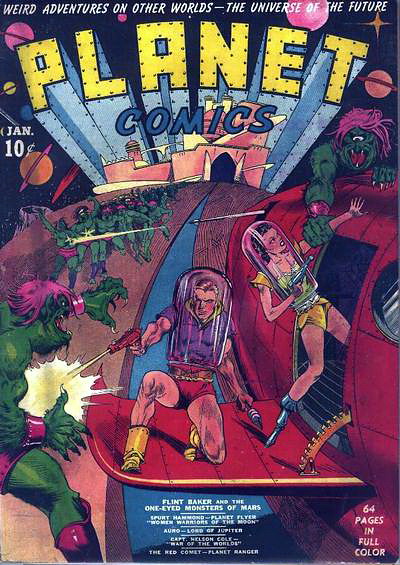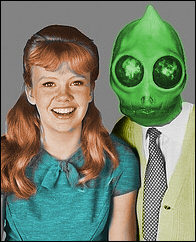From the silly yet earnest early artwork depicting the hopeful future that still seemed to be steam-powered in spite of claims of cosmic and atomic power to the latter-day cover art that depicted hostile and strange life forms poised to consume and assimilate all civilizations, Planet Comics by publisher Fiction House is one of my favorite comic book titles. Not only did it feature Futura, a star-lost woman who alone fights for her freedom against human tyrants and aliens, but the title was both a perfect reflection and herald of trends in science fiction.
The long-running Planet Comics serials revealed what was popular, woefully passe and perhaps even what was anticipated in entertainment media of the genre. Styles were aped and innovation occurred in quantity. Aside from the tales the thematic transformations of the covers were likewise a good indicator of the changes that occurred over time to popular science fiction and the tastes of the market. Particularly noteworthy are the covers that feature women as being depicted as other than damsels in need of rescuing. While this happened more than some would think in the pulps and comics it was actually reflected in the stories within the magazine with the tales of Futura, Gale Allen and Mysta being prime examples. Though the artwork often favored stereotypical male power fantasies there are a number of covers that are progressive for the time.
Witness the evolution of 73 issues of Planet Comics from the early Pulp influences to the distinctive EC house-style of the 1950s by clicking the picture.
The long-running Planet Comics serials revealed what was popular, woefully passe and perhaps even what was anticipated in entertainment media of the genre. Styles were aped and innovation occurred in quantity. Aside from the tales the thematic transformations of the covers were likewise a good indicator of the changes that occurred over time to popular science fiction and the tastes of the market. Particularly noteworthy are the covers that feature women as being depicted as other than damsels in need of rescuing. While this happened more than some would think in the pulps and comics it was actually reflected in the stories within the magazine with the tales of Futura, Gale Allen and Mysta being prime examples. Though the artwork often favored stereotypical male power fantasies there are a number of covers that are progressive for the time.
Witness the evolution of 73 issues of Planet Comics from the early Pulp influences to the distinctive EC house-style of the 1950s by clicking the picture.

Planet Comics by Fiction House Publishers (January 1940-Winter 1953).



























No comments:
Post a Comment
Moderation enabled only because of trolling, racist, homophobic hate-mongers.
Note: Only a member of this blog may post a comment.